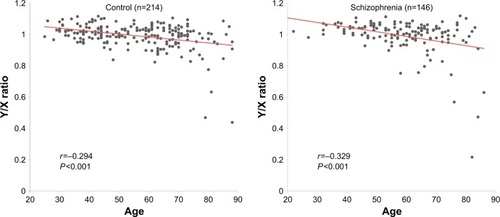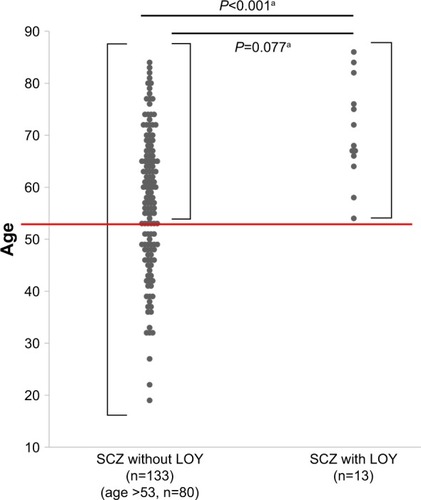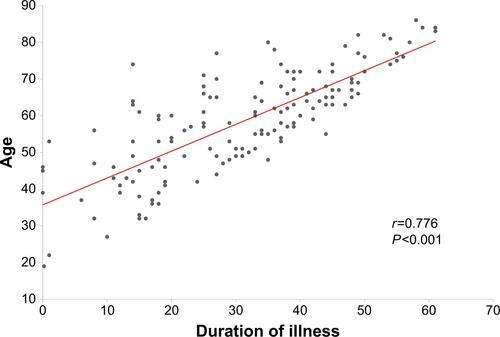Abstract
Background
Life expectancy is 10–20 years lower in patients with schizophrenia than in the general population. In addition, men with schizophrenia have an earlier age at onset, more pronounced deficit symptoms, poorer course, and poorer response to antipsychotic medications than women. Recent studies have indicated that loss of chromosome Y (LOY) in peripheral blood is associated with an increased risk of all-cause mortality. In order to elucidate the pathophysiology of male-specific features, we investigated the association between LOY and schizophrenia.
Materials and methods
The present study included 360 Japanese men (146 patients with schizophrenia vs 214 controls). The relative amount of Y chromosome was defined as the ratio of chromosome Y to chromosome X (Y/X ratio) based on the fluorescent signal of co-amplified short sequences from the Y-X homologous amelogenin genes (AMELY and AMELX).
Results
There was no significant difference in the frequency of LOY between the schizophrenia and control groups. However, longer duration of illness was associated with LOY after controlling for age and smoking status in the schizophrenia group (P=0.007, OR =1.11 [95% CI =1.03–1.19]).
Conclusion
According to our results, schizophrenia may not have a remarkable effect on blood LOY; however, LOY may be associated with disease course in patients with schizophrenia.
Introduction
Schizophrenia is a severe psychiatric disorder that exerts a profound impact on the individual and society, primarily due to chronic negative symptoms such as impaired motivation, reductions in spontaneous speech, and cognitive impairment. Furthermore, it is well-known that mortality rates for schizophrenia are extremely high. Indeed, several studies have suggested that schizophrenia is associated with an increased risk of mortality, reducing the life expectancy of affected individuals by 10–20 years relative to that in the general population.Citation1,Citation2 For several decades, schizophrenia was generally believed to be associated with a uniform lifetime morbid risk of 1%,Citation3 although these effects may be influenced by smoking and other lifestyle factors.
Numerous family studies, twin and adoption studies, candidate gene analyses, and genome-wide association studies (GWASs) have suggested that genetic factors contribute to the etiology of schizophrenia.Citation4 In addition, several features of schizophrenia are thought to be sex-specific, as the incidence of the disorder is 1.4 times higher among men than among women. Relative to women, men with schizophrenia exhibit an earlier age at onset, poorer premorbid history, a higher frequency of prenatal and perinatal complications, more pronounced deficits, poorer course, and poorer response to typical antipsychotic medications.Citation5 Despite these findings, it remains unclear how sex differences influence the pathophysiology of schizophrenia.
Male-specific genetic risk factors such as loss of chromosome Y (LOY) in blood cells may help to elucidate the role of sex differences in schizophrenia. LOY is primarily discussed as a mosaic event, in which a mixture of cells with and without the Y chromosome can be observed in the peripheral blood of normally aging men.Citation6 At the cellular level, LOY is a binary phenomenon: that is, a cell either has the Y chromosome or does not. Several studies have reported LOY in men of advanced age, suggesting that LOY is associated with aging.Citation7–Citation11 Other studies have demonstrated that smoking is a major risk factor for LOY in the blood.Citation11,Citation12 Further, the median survival time after sampling of men with LOY is 5.5 years shorter than that observed in controls.Citation13 Several research groups have also observed increased LOY in various diseases, such as hematological malignancies,Citation14 non-hematological tumors,Citation15 Alzheimer’s disease,Citation9 and autoimmune thyroiditis.Citation16 Fontenelle et al further reported an association between LOY and Asperger’s syndrome,Citation17 and our recent study demonstrated that increased LOY can be observed in those who have completed suicide.Citation18 However, no previous study has examined the association between LOY and schizophrenia. In the present study, we conducted the first investigation of LOY in patients with schizophrenia.
Materials and methods
Participants
The present study was approved by the Ethical Committee for Genetic Studies of Kobe University Graduate School of Medicine, and our study design and all related procedures were performed in accordance with the Declaration of Helsinki. All participants provided written informed consent, were of Japanese descent, and were recruited from among the population of Kobe, Japan.
This study cohort consisted of 146 men with schizophrenia (median age: 60.0 years, interquartile range [IQR 49.0–68.0] years) and 214 age-matched controls (214 men; median age: 58.5 years, [IQR 43.0–68.0] years). The demographic and clinical characteristics of the participants are presented in .
Table 1 Demographic and clinical characteristics of participants for loss of chromosome Y study
All patients with schizophrenia were diagnosed by at least two psychiatrists in accordance with criteria outlined in the Diagnostic and Statistical Manual of Mental Disorders, fourth edition (DSM-IV) or DSM-5 based on unstructured interviews and reviews of their medical records. The control group included healthy volunteers. None of the control participants had any present, past, or family (first-degree relatives) history of psychiatric disorders or substance abuse, excluding nicotine dependence. All control participants were interviewed and screened for psychiatric disorders based on an unstructured interview performed by a psychiatrist. We obtained information regarding smoking status for each patient with schizophrenia, although such information was not available for control participants.
Determination of LOY in peripheral blood
Peripheral blood samples were stored at −80°C prior to analysis. DNA was extracted using the QIAamp DNA Blood Midi Kit (Qiagen NV, Venlo, the Netherlands), in accordance with the manufacturer’s instructions. Extracted DNA was quantified and underwent quality control using a NanoDrop spectrophotometer (Thermo Fisher Scientific, Waltham, MA, USA). LOY was determined using quantitative fluorescence polymerase chain reaction as previously described.Citation15,Citation19,Citation20
The relative amount of Y chromosome was defined as the ratio of chromosome Y to chromosome X (Y/X ratio) based on the fluorescent signal of co-amplified short sequences from the Y-X homologous amelogenin genes (AMELY and AMELX). The ratio was discriminated based on a 6-base pair (bp) deletion in intron 1 of AMELX (106-bp fragment), which is not found in AMELY (112-bp fragment). Deletions or duplications in the AMELY region were excluded using a co-amplified homologous sequence primer set for MYPT2 on chromosome 1 (176-bp fragment) and MYPT2 on chromosome Y (two copies of 181-bp fragments). In addition, using another co-amplified homologous sequence set for TAF9B on chromosome 3 (140-bp fragment) and the X chromosome (144-bp fragment), we verified that there were no false positive cases of X chromosome loss or gain in the present study. An AMELY/X ratio of 1 indicates a normal result for male DNA samples due to the presence of one X and one Y chromosome. The normal MYPT2/MYPT2Y ratio is approximately one due to the presence of two copies of the gene on the Y chromosome and one copy on each copy of chromosome 1. The normal TAF9B-X/TAF9B-chr 3 ratio is 0.5 due to the presence of two copies of the gene on chromosome 3 and one copy on the X chromosome in male individuals.
The polymerase chain reaction (PCR) reaction mixture contained 2.5 µL AmpliTaq Gold 360 Master Mix (Applied Biosystems, Thermo Fisher Scientific), 20 ng genomic DNA, and 3 pmol of each primer, resulting in a total volume of 10 µL. PCR was performed under the following conditions: initial denaturation at 95°C for 5 minutes, 28 cycles denaturation cycles at 95°C for 1 minute each, annealing at 58°C for 1 minute, elongation at 72°C for 1.5 minute, and final elongation at 72°C for 30 minutes. PCR products were run on an Applied Biosystems 3,130 XL Genetic Analyzer (Applied Biosystems, Thermo Fisher Scientific) with GeneScan 600 LIZ (Applied Biosystems, Thermo Fisher Scientific) as an internal standard and were analyzed using GeneMapper version 4.1 (Applied Biosystems, Thermo Fisher Scientific). Because co-amplified fragments from the X and Y chromosomes exhibit a 6-bp difference (106 bp vs 112 bp, respectively), they are readily separated and quantified via capillary electrophoresis. Laboratory personnel were blinded regarding case–control status, and the sample order was randomized in each batch.
Statistical analysis
Statistical analysis was performed using R version 3.4.1 (The R Foundation for Statistical Computing, Vienna, Austria) equipped with EZR version 1.36.Citation21 Differences between groups were analyzed using Mann–Whitney U-tests, Fisher’s exact tests, Cochran–Armitage trend tests, and logistic regression analysis, as appropriate. Relationships between continuous variables were analyzed using Spearman’s rank correlation coefficient. We evaluated the presence or absence of LOY, coding Y/X ratios <0.9 as LOY and Y/X ratios ≥0.9 as normal. This threshold was based on previous findings, which revealed that detection of LOY from single nucleotide polymorphism (SNP)-array data is robust and reproducible when LOY occurs in ≥10% of the nucleated cells in a blood sample.Citation6,Citation12,Citation13 Dummy variables were used as necessary (phenotype, control =0, schizophrenia =1; smoking, no =0, past =1, yes =2). Statistical significance was defined as two-tailed P-values <0.05.
Results
LOY in peripheral blood
Spearman’s correlation coefficients revealed negative correlations between age and Y/X ratio in both the schizophrenia (r=−0.329, P<0.001) and control (r=−0.294, P<0.001) groups (), in accordance with the findings of previous studies.Citation7–Citation11 Thirteen of 146 (8.9%) patients and 18 of 214 (8.4%) controls exhibited LOY (Y/X ratio <0.9). As such, there was no significant difference in the frequency of LOY between the schizophrenia and control groups (P=0.851) (). Logistic regression analysis revealed no significant effect of age on phenotype (P=0.982) ().
Table 2 Logistic regression analysis of LOY in peripheral blood samples from patients with schizophrenia and controls
Figure 1 Relationship between age and Y/X ratio in blood samples from patients with schizophrenia and controls. All P-values and r values were calculated using Spearman’s rho test.

Next, we investigated the effect of schizophrenia duration on LOY. We observed a positive correlation between the duration of illness and age in the schizophrenia group (r=0.776, P<0.001) (). To adjust for the effects of age bias in subsequent analysis, we utilized data from patients with schizophrenia over the age of 53 – the lower limit for LOY observed in the present study. In this subgroup, the duration of illness was significantly longer in patients with LOY than in those without LOY (P=0.0016), and there were no significant differences in age between patients with LOY and those without LOY (P=0.077) ( and ). Moreover, we observed no effects of smoking status or antipsychotic dose. To rule out potential confounders, we performed a logistic regression analysis, in which LOY was the response variable, while duration of illness, smoking status, and antipsychotic dose were the explanatory variables. The duration of illness was robustly associated with LOY (P=0.007, OR =1.11 [95% CI =1.03–1.19]) (). However, no significant effect of age was observed (P=0.109) ().
Table 3 Logistic regression analysis of LOY in peripheral blood samples of patients with schizophrenia
Figure 2 Dot plot of age for men with and without LOY in schizophrenia.
Abbreviations: LOY, loss of chromosome Y; SCZ, schizophrenia; IQR, inter-quartile range.

Discussion
To our knowledge, the present study is the first investigation of LOY among patients with schizophrenia. Because the association between age and LOY has been well documented, we focus on age-adjusted comparisons between the groups. In accordance with previous findings, our analyses revealed an association between LOY and age in both the schizophrenia and control groups.Citation7–Citation11 However, there was no significant difference in LOY between the two groups. In contrast, we observed that longer duration of schizophrenia was associated with LOY regardless of smoking status or daily antipsychotic dose.
Our results suggested that LOY was correlated with the duration of schizophrenia, but not with disease status. The association between age and LOY has been well documented. In addition, several research groups have also observed increased LOY in patients with aging-associated diseases, such as myelodysplastic syndromeCitation22 and Alzheimer’s disease.Citation9 Taken together, these findings indicate that increases in LOY may also occur over a prolonged period in patients with schizophrenia.
Several studies have demonstrated that smoking is a major risk factor for LOY, and that the mutagenic effects are transient and dose-dependent.Citation11,Citation12 As smoking data were unavailable for control participants, we referred to public epidemiological data for smoking rates in Japan.Citation23 Our analysis revealed that patients with schizophrenia exhibited a higher average smoking rate than that observed in the general population (41.7% vs 34.1%; ), in accordance with the findings of previous studies.Citation24,Citation25 However, we observed no significant difference in LOY between the schizophrenia and control groups, suggesting that differences in smoking rate do not influence the effect of smoking on LOY.
Recent European GWASs found that LOY was related to cell cycle regulation and genome instability.Citation10,Citation11 We hypothesized that disturbed cell cycle regulation and genomic instability play important roles in the pathophysiology of schizophrenia. Indeed, several studies have demonstrated that schizophrenia involves the aberrant regulation of cell cycle-related genes in the brain and peripheral blood, along with chromosomal aneuploidy in the brain.Citation26–Citation31 Furthermore, a recent high-resolution genome-wide copy number variation (CNV) analysis using data derived from the Japanese population suggests that genomic instability is associated with the pathophysiology of schizophrenia, mainly due to genomic replication errors.Citation32 However, no studies to date have revealed mechanistic links between genomic instability and schizophrenia. Further research is required to elucidate the mechanisms underlying the pathophysiology of schizophrenia.
There are several limitations in the present study. First, clinical information regarding smoking status, a factor known to affect LOY,Citation11,Citation12 was not available for our control participants. Although we investigated the influence of smoking on LOY using publicly available epidemiological data, it is unclear whether this influence was similar in our control participants. Future studies should include detailed information regarding smoking status (ie, cigarettes per day, duration of smoking) for both the schizophrenia and control groups. Second, we adjusted age to compare the duration of illness between participants with and without LOY in the schizophrenia group. However, precise elimination of the age effect requires an age-static cohort, in which all participants are sampled at the same age. Third, our calculations of antipsychotic dose may have been inaccurate, as these values reflected those at the time of blood sampling, and we did not integrate medication history. Finally, the sample size of our study may have been insufficient for detecting associations between schizophrenia and LOY. Larger sample sizes are required in future studies.
Conclusion
This study indicated that schizophrenia may not have a remarkable effect on blood LOY; however, LOY might be involved in the disease course of schizophrenia. Our findings shed light on further investigation of LOY toward an improved understanding of the sex-specific features of schizophrenia.
Acknowledgments
This work was supported in part by the Japan Society for the Promotion of Science (JSPS) KAKENHI Grant Numbers JP15K19727 and JP16K19765. We thank Yasuko Nagashima for providing technical assistance.
Supplementary materials
Figure S1 Correlation between duration of illness and age in patients with schizophrenia. P-value and r values were calculated using Spearman’s rho test.

Table S1 Comparisons of demographic and clinical characteristics between participants with and without LOY in the schizophrenia group
Table S2 Logistic regression analysis of LOY in peripheral blood samples of patients with schizophrenia
Table S3 Smoking rates in Japanese men
Disclosure
The authors report no conflict of interest in this work.
References
- ChesneyEGoodwinGMFazelSRisks of all-cause and suicide mortality in mental disorders: a meta-reviewWorld Psychiatry201413215316024890068
- SahaSChantDMcGrathJA systematic review of mortality in schizophrenia: is the differential mortality gap worsening over time?Arch Gen Psychiatry200764101123113117909124
- MueserKTMcGurkSRSchizophreniaLancet200436394262063207215207959
- SullivanPFKendlerKSNealeMCSchizophrenia as a complex trait: evidence from a meta-analysis of twin studiesArch Gen Psychiatry200360121187119214662550
- AbelKMDrakeRGoldsteinJMSex differences in schizophreniaInt Rev Psychiatry201022541742821047156
- ForsbergLALoss of chromosome Y (LOY) in blood cells is associated with increased risk for disease and mortality in aging menHum Genet2017136565766328424864
- WiktorAEvan DykeDLHodnefieldJMEckel-PassowJHansonCAThe significance of isolated Y chromosome loss in bone marrow metaphase cells from males over age 50 yearsLeuk Res201135101297130021703685
- JacobsPAMaloneyVCookeRCrollaJAAshworthASwerdlowAJMale breast cancer, age and sex chromosome aneuploidyBr J Cancer2013108495996323299533
- DumanskiJPLambertJCRasiCMosaic loss of chromosome Y in blood is associated with Alzheimer diseaseAm J Hum Genet20169861208121927231129
- WrightDJDayFRKerrisonNDGenetic variants associated with mosaic Y chromosome loss highlight cell cycle genes and overlap with cancer susceptibilityNat Genet201749567467928346444
- ZhouWMachielaMJFreedmanNDMosaic loss of chromosome Y is associated with common variation near TCL1ANat Genet201648556356827064253
- DumanskiJPRasiCLönnMMutagenesis. Smoking is associated with mosaic loss of chromosome YScience20153476217818325477213
- ForsbergLARasiCMalmqvistNMosaic loss of chromosome Y in peripheral blood is associated with shorter survival and higher risk of cancerNat Genet201446662462824777449
- PierreRVHoaglandHCAge-associated aneuploidy: loss of Y chromosome from human bone marrow cells with agingCancer19723048898944116908
- NoveskiPMadjunkovaSSukarova StefanovskaELoss of Y chromosome in peripheral blood of colorectal and prostate cancer patientsPLoS One2016111e014626426745889
- PersaniLBonomiMLleoAIncreased loss of the Y chromosome in peripheral blood cells in male patients with autoimmune thyroiditisJ Autoimmun2012382–3J193J19622196921
- FontenelleLFMendlowiczMVBezerra de MenezesGdos Santos MartinsRRVersianiMAsperger syndrome, obsessive-compulsive disorder, and major depression in a patient with 45, X/46, XY mosaicismPsychopathology200437310510915153741
- KimuraAHishimotoAOtsukaILoss of chromosome Y in blood, but not in brain, of suicide completersPLoS One2018131e019066729300758
- SullivanKMMannucciAKimptonCPGillPA rapid and quantitative DNA sex test: fluorescence-based PCR analysis of X-Y homologous gene amelogeninBiotechniques19931546366386406418251166
- Plaseska KaranfilskaDNoveskiPPlaseskiTDetection of the most common genetic causes of male infertility by quantitative fluorescent (QF)-PCR analysisPlaseska-KaranfilskaDHuman Genetic DiseasesInTech2011978-953-307936-3 Available from: https://www.intechopen.com/books/human-genetic-diseases/detection-of-the-most-common-genetic-causes-of-male-infertility-by-quantitative-fluorescent-qf-pcr-aAccessed August 08, 2018
- KandaYInvestigation of the freely available easy-to-use software ‘EZR’ for medical statisticsBone Marrow Transplant201348345245823208313
- GansterCKämpfeDJungKNew data shed light on Y-loss-related pathogenesis in myelodysplastic syndromesGenes Chromosomes Cancer2015541271772426394808
- NIBIOHN [webpage on the Internet]The National Health and Nutrition Survey Japan2012 Available from: http://www.nibiohn.go.jp/eiken/english/research/project_nhns.htmlAccessed July 27, 2018
- de LeonJDadvandMCanusoCWhiteAOStanillaJKSimpsonGMSchizophrenia and smoking: an epidemiological survey in a state hospitalAm J Psychiatry199515234534557864277
- ZiedonisDWilliamsJMSmelsonDSerious mental illness and tobacco addiction: a model program to address this common but neglected issueAm J Med Sci2003326422323014557739
- KatselPDavisKLLiCAbnormal indices of cell cycle activity in schizophrenia and their potential association with oligodendrocytesNeuropsychopharmacology200833122993300918322470
- BenesFMLimBSubburajuSSite-specific regulation of cell cycle and DNA repair in post-mitotic GABA cells in schizophrenic versus bipolarsProc Natl Acad Sci U S A200910628117311173619564623
- WangLLockstoneHEGuestPCExpression profiling of fibroblasts identifies cell cycle abnormalities in schizophreniaJ Proteome Res20109152152719916557
- OkazakiSBokuSOtsukaIThe cell cycle-related genes as biomarkers for schizophreniaProgr Neuro psychopharmacol Biol Psychiatry2016708591
- YurovYBIourovIYVorsanovaSGThe schizophrenia brain exhibits low-level aneuploidy involving chromosome 1Schizophr Res2008981–313914717889509
- YurovYBVostrikovVMVorsanovaSGMonakhovVVIourovIYMulticolor fluorescent in situ hybridization on post-mortem brain in schizophrenia as an approach for identification of low-level chromosomal aneuploidy in neuropsychiatric diseasesBrain Dev200123Suppl 1S186S19011738870
- KushimaIAleksicBNakatochiMHigh-resolution copy number variation analysis of schizophrenia in JapanMol Psychiatry201722343044027240532

